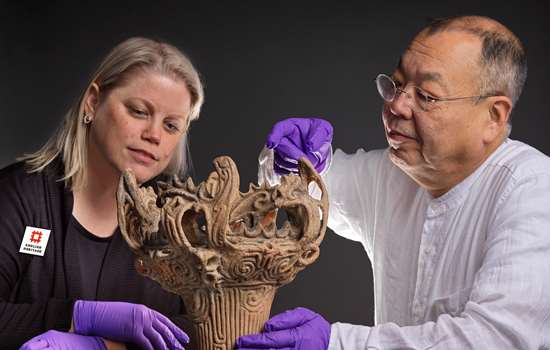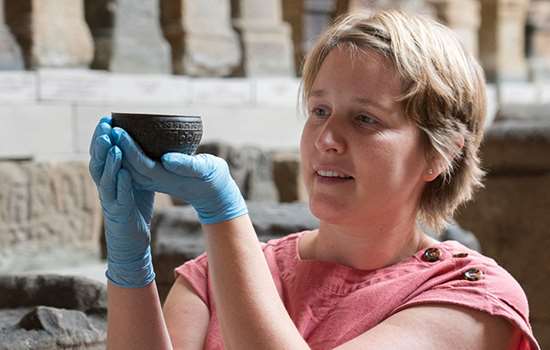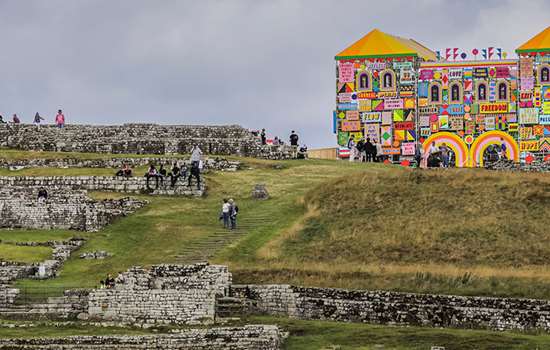29/07/2020
New research reveals origin of Stonehenge’s great sarsen stones
A new study has revealed the origins of Stonehenge's sarsen stones, solving a mystery that has been speculated on for centuries.
New research reveals the origin of Stonehenge’s giant sarsen stones as West Woods, on the edge of Wiltshire’s Marlborough Downs.
The mystery of the stones’ origins has been published in the journal Science Advances. Led by geomorphologist Professor David Nash, and jointly authored by a team including English Heritage historian Susan Greaney, the study has pinpointed the source of the megaliths to an area around 15 miles north of the stone circle site.
Typically weighing 20 tonnes and standing up to 7 metres tall, sarsens form all fifteen stones of Stonehenge’s central horseshoe. This includes the uprights and lintels of the outer circle, as well as outlying stones such as the Heel Stone, the Slaughter Stone and the Station Stones.
Fifty-two of what are believed to be the original 80 sarsens remain in situ. While the monument’s smaller bluestones have been traced to specific locations in the Preseli Hills in Wales, the sarsens - more homogenous in composition - have been impossible to identify until now.
The breakthrough came when a core - drilled from Stonehenge’s ‘Stone 58’ during repair work in the 1950s - was returned to English Heritage from Florida last year. This was at the request of one of those involved at the time, Mr Robert Phillips. This presented Professor Nash with a unique opportunity to analyse the interior of one of Stonehenge’s great sarsens.
Working with colleagues from leading universities, in a British Academy funded project, the team first carried out non-destructive testing of all the remaining sarsens at Stonehenge. This revealed that most – including Stone 58 – shared a similar chemistry and came from the same area.
They then analysed sarsen outcrops from Norfolk to Devon and compared their chemical composition with the chemistry of a piece of the returned core.
The opportunity to do a destructive test on the core proved decisive as it showed that the composition of Stone 58 matched the chemistry of sarsens at West Woods, just south of Marlborough. This is approximately a 40 minute drive from Stonehenge today.
English Heritage Senior Properties Historian Susan Greaney said:
'To be able to pinpoint the area that Stonehenge’s builders used to source their materials around 2500 BC is a real thrill. Now we can start to understand the route they might have travelled and add another piece to the puzzle.
'While we had our suspicions that Stonehenge’s sarsens came from the Marlborough Downs, we didn’t know for sure, and with areas of sarsens across Wiltshire, the stones could have come from anywhere.
'We can now say, when sourcing the sarsens, the over-riding objective was size – they wanted the biggest, most substantial stones they could find and it made sense to get them from as nearby as possible. This is in stark contrast to the source of the bluestones, where something quite different - a sacred connection to these mountains perhaps – was at play.
'Yet again this evidence highlights just how carefully considered and deliberate the building of this phase of Stonehenge was.'
Professor David Nash, University of Brighton, said:
'It has been really exciting to harness 21st century science to understand the Neolithic past, and finally answer a question that archaeologists have been debating for centuries.
'We were able to investigate the chemistry of the sarsens at Stonehenge using x-ray fluorescence, a non-destructive technique. This showed that most of the stones shared a similar chemistry and likely came from a similar source.
'We then applied mass spectroscopy to samples from sarsen outcrops across southern England and to tiny pieces of the Phillips’ Core from Stonehenge. Each outcrop was found to have a different geochemical signature, but it was the chance to test the returned core that enabled us to determine the source area for the Stonehenge sarsens.
'We’re incredibly grateful to the Phillips family for returning the core to us.'
Plan your visit to Stonehenge today.
See the stones up close with a Stone Circle Experience ticket.
For more from English Heritage, follow us on Twitter, Facebook and Instagram.



